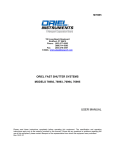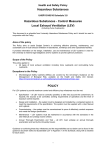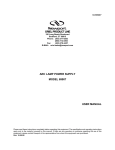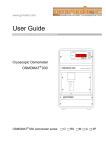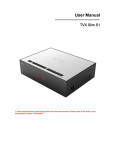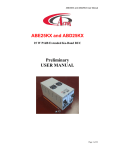Download Newport / Oriel Universal Arc Lamp Housings Manual
Transcript
Artisan Technology Group is your source for quality new and certified-used/pre-owned equipment • FAST SHIPPING AND DELIVERY • TENS OF THOUSANDS OF IN-STOCK ITEMS • EQUIPMENT DEMOS • HUNDREDS OF MANUFACTURERS SUPPORTED • LEASING/MONTHLY RENTALS • ITAR CERTIFIED SECURE ASSET SOLUTIONS SERVICE CENTER REPAIRS Experienced engineers and technicians on staff at our full-service, in-house repair center WE BUY USED EQUIPMENT Sell your excess, underutilized, and idle used equipment We also offer credit for buy-backs and trade-ins www.artisantg.com/WeBuyEquipment InstraView REMOTE INSPECTION LOOKING FOR MORE INFORMATION? Visit us on the web at www.artisantg.com for more information on price quotations, drivers, technical specifications, manuals, and documentation SM Remotely inspect equipment before purchasing with our interactive website at www.instraview.com Contact us: (888) 88-SOURCE | [email protected] | www.artisantg.com M-66055 ORIEL PRODUCT LINE 150 Long Beach Boulevard Stratford, CT 06615 Phone: (203) 377-8282 (800) 714-5393 Fax: (203) 378-2457 E-MAIL: [email protected] UNIVERSAL ARC LAMP HOUSING MODEL 66055 USER MANUAL Please read these instructions completely before operating this equipment. The specification and operating instructions apply only to the model(s) covered by this manual. If there are any questions or problems regarding the use of this equipment, please contact Newport or the representative from whom this equipment was purchased. Rev:7/27/05 Artisan Technology Group - Quality Instrumentation ... Guaranteed | (888) 88-SOURCE | www.artisantg.com M-66055 UNIVERSAL ARC LAMP HOUSING TABLE OF CONTENTS I. INTRODUCTION................................................................................................................................... 1 II. SUMMARY OF HAZARDS ................................................................................................................... 3 II.1 RADIATION............................................................................................................................ 3 II.2 LAMP EXPLOSION................................................................................................................ 3 II.3 OZONE .................................................................................................................................. 3 II.4 ELECTRICAL SHOCK ........................................................................................................... 4 II.5 EMI ......................................................................................................................................... 4 II.6 HEAT...................................................................................................................................... 4 III. GENERAL DESCRIPTION ................................................................................................................... 5 III.1 LAMP AND REFLECTOR ADJUSTMENTS .......................................................................... 5 III.2 LAMP COOLING.................................................................................................................... 5 III.3 SAFETY AND MONITORING FEATURES............................................................................ 5 III.4 HOUSINGS WITHOUT CONDENSING LENSES ................................................................. 6 III.5 MOUNTING............................................................................................................................ 6 IV. LAMP INSTALLATION AND INITIAL OPERATION ........................................................................... 10 IV.1 ADJUSTMENT OF LAMP, MIRROR AND LENS ................................................................ 13 IV.1.1 IV.1.2 IV.1.3 IV.1.4 General ............................................................................................................................. 13 Adjustments Prior to Operation ......................................................................................... 13 Adjustment During Operation ............................................................................................ 13 Lamp Operation and Cooling ............................................................................................ 14 IV.2 COOLING............................................................................................................................. 15 IV.2.1 IV.2.2 V. Xenon and Mercury (Xenon) Lamps ................................................................................. 15 Mercury Lamps ................................................................................................................. 15 LAMP HOUSING OPTICS .................................................................................................................. 17 V.1 COLLIMATED BEAMS ........................................................................................................ 18 V.2 UNIFORMITY....................................................................................................................... 19 V.3 IMAGING THE ARC............................................................................................................. 19 V.4 REAL LENSES..................................................................................................................... 20 V.4.1 V.4.2 V.5 Spherical Aberration........................................................................................................... 20 Chromatic Aberration ......................................................................................................... 21 HOW DO YOU POSITION THE CONDENSER TO GET A COLLIMATED BEAM? ........... 21 VI. TROUBLE SHOOTING....................................................................................................................... 22 VI.1 INTRODUCTION.................................................................................................................. 22 VI.2 PROBLEMS ......................................................................................................................... 22 VII. WARRANTY AND RETURNS ............................................................................................................ 25 Artisan Technology Group - Quality Instrumentation ... Guaranteed | (888) 88-SOURCE | www.artisantg.com M-66055 UNIVERSAL ARC LAMP HOUSING LIST OF FIGURES Figure 1: Lamp and reflector adjustments. .................................................................................................. 7 Figure 2: Safety interlock and electrical sockets. ........................................................................................ 8 Figure 3: Dimensional Diagram ................................................................................................................... 9 Figure 4: Correct operating position for arc lamps. ................................................................................... 11 Figure 5: Arc lamp inside housing. ............................................................................................................ 12 Figure 6: The electrodes viewed on a screen in front of the condenser.................................................... 14 Figure 7: Correctly positioned reflector...................................................................................................... 14 Figure 8: Attaching baffle plate .................................................................................................................. 16 Figure 9: Collimated Beams ...................................................................................................................... 18 Figure 10: The collimated output of a 200 W Hg lamp in the vertical and horizontal planes. ................... 19 Figure 11: A source focused to a smaller image. ...................................................................................... 19 Figure 12: Spherical Aberration ................................................................................................................. 20 Figure 13: Chromatic aberration ................................................................................................................ 21 Figure 14: Installing trigger wire on Xe lamp. ............................................................................................ 23 Artisan Technology Group - Quality Instrumentation ... Guaranteed | (888) 88-SOURCE | www.artisantg.com M-66055 UNIVERSAL ARC LAMP HOUSING I. INTRODUCTION This manual covers the Oriel 50 to 500 watt (W) Universal Lamp Housings. We divide them into two categories: housings for 50 to 250 W short arc lamps, and housings for 200 to 500 W lamps. 50 to 250 W Lamp Housings: 66055 Lamp Housing with no condenser 66056 Lamp Housing with Fl1.5 condenser 66057 Lamp Housing with Fl1 condenser 66058 Lamp Housing with F10.85 condenser 66059 Lamp Housing with Fl0.7 glass/fused silica condenser 66060 Lamp Housing with F10.7 fused silica condenser 200 to 500 W Lamp Housings: 66065 Lamp Housing with no condenser 66047 Lamp Housing with F11.5 condenser 66066 Lamp Housing with F11 condenser 66048 Lamp Housing with Fl0.85 condenser 66067 Lamp Housing with Fl0.7 glass/fused silica condenser 66068 Lamp Housing with F10.7 fused silica condenser The housings have the same basic design and differ in the condensing lens assembly and fan. With the appropriate socket adapter you can interchange between Hg, Xe, and Hg(Xe) lamps of different power. These lamp housings are designed to operate with Oriel Power Supplies. Table 1 on the following page shows the appropriate socket adapter for each lamp, and the power supply you should use. 1 Artisan Technology Group - Quality Instrumentation ... Guaranteed | (888) 88-SOURCE | www.artisantg.com M-66055 UNIVERSAL ARC LAMP HOUSING Table 1: Appropriate Socket Adapters and Power Supplies for Oriel Lamp Housings Lamp Lamp Housing 50 to 250 W 200 to 500 W Type 75 75 150 150 150 150 50 W Xe W Xe OF W Xe W Xe UV W Xe OF W Xe W Xe Model No. Socket Adapter Basic Power Supply* Fully Featured Power Supply 6251 6263 6253 6254 6255 6256 6282 66150 66150 66151 66151 66151 66152 66158 68806 68806 68806 68806 68806 68806 68806 68805 Universal 68805 Universal 68805 Universal 68805 Universal 68805 Universal 68805 Universal 68805 Universal 100 W Hg 6281 66150 68806 68805 Universal 200 W Hg 6283 66153 68806 6291 6292 66152 66152 68806 68806 68805 Universal 68810 Hg only 68805 Universal 68805 Universal 200 W Hg 6283 66144 68806 350 W Hg 6286 66161 68805 Universal 68810 Hg only 68810 Hg only 500 W Hg 6285 66162 68810 Hg only 300 W Xe 300 W Xe OF 400 W Xe 200 W Hg(Xe) 6259 6258 6260 6291 66160 66160 200 W Hg(Xe)OF 6292 66157 500 W Hg(Xe) 66159 68811 Xe only 68811 Xe only 68811 Xe only 68805 Universal 68811 Xe only 68805 Universal 68811 Xe only 68811 Xe only 66142 Not Required 66157 Ignitor 58705 Universal 58705 Universal 88705 Universal 68705 Universal 68705 Universal 68705 Universal 58705 Universal 68709 Hg only 68705 Universal 68709 Hg only 68705 Universal 68709 Hg only 68705 Universal 68705 Universal 68705 Universal 68709 Hg only 68705 Universal 68709 Hg only 68705 Universal 68709 Hg only 68705 Universal 68705 Universal 68705 Universal 68705 Universal 68705 Universal 68705 Universal * Has built-in ignitor *' Requires external ignitor 2 Artisan Technology Group - Quality Instrumentation ... Guaranteed | (888) 88-SOURCE | www.artisantg.com M-66055 UNIVERSAL ARC LAMP HOUSING II. SUMMARY OF HAZARDS There are six hazards in the operation of systems employing these lamp housings. They are: Radiation Lamp Explosion Ozone Electrical Shock EMI Heat II.1 RADIATION The high intensity UV radiation of these lamps can permanently damage the cornea, lens, and retina of the eye, even causing blindness. This damage may not be immediately apparent. The deep UV is absorbed in the cornea or eye fluids; focused UV, VIS and NIR can damage the retina. Normal blink reaction to visible light may not be adequate protection, and a beam of invisible UV or NIR (produced by spectral filtering) can be most dangerous, as the blink response is not induced. UV radiation can also cause painful sunburn, and with prolonged exposure, serious burns. Recommendations: 1. Never look directly into the output beam of a housing when operating a lamp. 2. Never look at a specular (mirror) reflection of the beam, even for short periods of time. 3. Use the interlock system to prevent access to a working lamp. 4. Always wear UV safety eyewear or facemask, and protective clothing for exposed areas of skin. II.2 LAMP EXPLOSION When cold, xenon and mercury (xenon) arc lamps are under several atmospheres of pressure and are subject to explosion due to internal strains or to physical abuse. When hot, all lamps are under a pressure of close to 100 atmospheres and subject to violent explosion. Recommendations: 1. Do not handle a bare arc lamp without safety goggles and adequate protection for exposed areas of skin. 2. Do not apply torque to the lamp envelope during Installation or removal. 3. Do not touch the lamp envelope. Fingerprints and other contaminations left on the lamp cause a Thoroughly clean the envelope after installation in the housing with alcohol or a dilute solution of detergent and water. II.3 OZONE Shortwave ultraviolet light photolyzes oxygen to produce ozone. This is emitted in the cooling air stream of the lamp housing. There is no simple way of predicting the ozone concentration (or its impact on you) e.g., operation in a small enclosed area may lead to high concentrations. Operation of the same system in a large, well ventilated laboratory may not be a problem. Recommended maximum exposures are typically: 0.1 ppm for 8 hours exposure 2 ppm for a 2 hour exposure 3 Artisan Technology Group - Quality Instrumentation ... Guaranteed | (888) 88-SOURCE | www.artisantg.com M-66055 UNIVERSAL ARC LAMP HOUSING A very sensitive nose can detect 0.015 ppm. 1 ppm produces a strong and obnoxious odor. As a rule of thumb, if you can easily smell ozone, the level is too high for prolonged exposure. Recommendations: 1. Use an ozone free lamp unless you need the shortwave UV. 2. Operate the system in a large ventilated area. 3. Use an Ozone Eater ™, found in our catalog. II.4 ELECTRICAL SHOCK Line voltage is supplied to the housing to power the fan and elapsed timer. Recommendations: 1. Keep personnel clear of all exposed terminals. 2. Before relamping or working on the system, disconnect the input power from the line, turn off the power supply and check the power supply voltmeter for zero voltage to be sure that internal capacitors are fully discharged. 3. Make sure all connections are securely made (and check the polarity) before starting a lamp. 4. Do not handle the lamp leads during lamp ignition. II.5 EMI Ignition of an arc lamp requires high voltage high frequency pulses. A high current dump (kHz discharge) follows. Both of these are sources of electromagnetic interference, both radiated and conducted. Good earthing and cable routing practice, and EMI shielding may be necessary to protect sensitive digital circuitry from these pulses. Recommendations: 1. Start the arc lamp before powering nearby computer systems. 2. Keep the computer at least 6 feet away from the ignitor/power supply. 3. Use a different outlet and line for the computer and ignitor/power supply. II.6 HEAT These lamps become hot after several minutes of operation, and remain very hot for up to 10 minutes after being shut off. Recommendations: 1. Do not touch the lamp with your bare hands for at least 10 minutes after the lamp is shut off. 4 Artisan Technology Group - Quality Instrumentation ... Guaranteed | (888) 88-SOURCE | www.artisantg.com M-66055 UNIVERSAL ARC LAMP HOUSING III. GENERAL DESCRIPTION These lamp housings are lightweight but rugged. They are excellent choices for most low to medium power laboratory lamps. You can mount them to optical tables, rails, or benches. Various models with different condensers are available. With the complete line of optical accessories described in Volume 11, you can filter, focus, and steer the output to fit your application. Both types of lamp housings described in this manual (50 to 250 W and 200 to 500 W), use the same shell. The 200 to 500 W models have a more powerful fan to ensure correct operating conditions for the higher wattage lamps, and a different mounting block to accept the larger lamps. III.1 LAMP AND REFLECTOR ADJUSTMENTS The position of the arc (relative to the terminals which secure the lamp) varies slightly from lamp to lamp. This is because of normal arc lamp manufacturing tolerances. These lamp housings have adjustments to place the arc of a new lamp in the same position as that of the lamp being replaced. Three fine controls position the reflector. Then, independent tilt controls position the arc horizontally and vertically. The reflector and its controls travel with the vertical and horizontal controls. This eliminates the need for iterative lamp-reflector adjustments. See Figure 1on page 7 for location of adjusters. III.2 LAMP COOLING The built in fan maintains the proper operating temperature for most arc lamps, when operated in normal laboratory ambient. Lamp housing is designed to operate in a typical laboratory environment (typically 68 to 76 degrees F, up to 45% relative humidity). Temperature and humidity outside of typical laboratory range can contribute to cooling and ignition faults. Cooling issues which will cause the over temperature sensor to open and ignition problems from high humidity. Contact Newport representative for more information if operating outside the suggested range.(Section IV.2 describe the use of a baffle for some lamps to prevent overcooling.) Overheating due to blocking of the cooling vents or an inoperative fan activates a thermostat interlock. The cooling fan can be operated on 110 or 220 volts AC line. The housings have an AC connector that is designed to accept U.S. style power cords. The housings are supplied with a power cord. If the power cord is not compatible with your wall socket, replace the plug at the end of the power cord. Check that the line select switch (below the fan) is in the appropriate 110/1220 V position before plugging the line cord into the nearest available AC outlet. The fan will run as long as power is applied to the housing. III.3 SAFETY AND MONITORING FEATURES These lamp housings incorporate safety interlocks. When used with an Oriel Power Supply the lamp automatically shuts off if the housing door is opened or the housing overheats. If you use your own power supply, we strongly recommend that you utilize this low voltage interlock system for safety. See Figure 2on page 8 or location of interlock. 5 Artisan Technology Group - Quality Instrumentation ... Guaranteed | (888) 88-SOURCE | www.artisantg.com M-66055 UNIVERSAL ARC LAMP HOUSING III.4 HOUSINGS WITHOUT CONDENSING LENSES The 66055 and 66065 Lamp Housings do not have a condenser, and therefore have a large aperture in the front of the housing. Block this aperture with your own condenser or a plate before operating the lamp. III.5 MOUNTING The lamp housings are supplied with four adjustable feet for free standing use. They allow 0.63 inch (16 mm) height adjustment. You can also mount the housing to tables, carriers, or translators with tapped holes on 1 inch or 25 mm centers. To do this you should remove the feet and use the three mounting points and screw slots. If you have a flat enough surface you can unscrew the three mounting pads and use the baseplate directly. See Figure 3 on page 9 for baseplate dimensions. 6 Artisan Technology Group - Quality Instrumentation ... Guaranteed | (888) 88-SOURCE | www.artisantg.com M-66055 UNIVERSAL ARC LAMP HOUSING INTERLOCKED LAMP ACCESS DOOR LAMP VERTICAL POSITION ADJUST REFLECTOR PINS AND ADJUST KNOBS LAMP HORIZONTAL POSITION ADJUST INCH MOUNTING SLOTS (4) METRIC MOUNTING SLOTS (4) Figure 1: Lamp and reflector adjustments. 7 Artisan Technology Group - Quality Instrumentation ... Guaranteed | (888) 88-SOURCE | www.artisantg.com M-66055 UNIVERSAL ARC LAMP HOUSING MAIN LAMP POWER - TO TOP OF LAMP 1 PIN PANEL MOUNT CONNECTOR AMPHENOL - MS3102A 12-5 TO FAN MAIN LAMP POWER – TO BOTTOM OF LAMP 1 PIN PANEL MOUNT CONNECTOR AMPHENOL - MS3102A 12-5 INTERLOCK 2 PIN FEMALE CONNECTOR CINCH JONES/TRW S-392-AB HOUSING VOLTAGE SELECTED SWITCH AC POWER SOCKET 3 WIRE AC CONNECTOR 15A 250 VAC SWITCHCRAFT EAC-302 Figure 2: Safety interlock and electrical sockets. 8 Artisan Technology Group - Quality Instrumentation ... Guaranteed | (888) 88-SOURCE | www.artisantg.com M-66055 UNIVERSAL ARC LAMP HOUSING Figure 3: Dimensional Diagram 9 Artisan Technology Group - Quality Instrumentation ... Guaranteed | (888) 88-SOURCE | www.artisantg.com M-66055 UNIVERSAL ARC LAMP HOUSING IV. LAMP INSTALLATION AND INITIAL OPERATION 1. Check that there is no electrical service to the housing and that the lamp power supply is off and discharged. 2. Put on safety goggles and gloves. 3. Unscrew the four thumb screws on the side of the housing and remove the access door. 4. Determine which orientation is correct for the lamp. For xenon and mercury (xenon) lamps, the anode (+ ve) is at the top. For mercury lamps the anode (+ ve) must be at the bottom. You can identify the anode by a + stamped on the lamp base. Any lamp identification writing or numbers will be the correct way up when the lamp is held in the correct operating orientation. See Figure 4 on page 11 for a diagram. 5. Install the appropriate adapter(s) on the lamp terminal(s). Depending on the lamp type, these socket adapters are fastened to the lamp terminals by set screws or by a threaded connection. If the lamp is supplied with knurled nuts, remove the bottom nut and discard before installing the socket adapter. One of the knurled nuts will be used to secure the wire lug to the top terminal. 6. Connect the top hanging lead to the top terminal, using either the knurled set screw supplied with the lamp, or the knurled set screw supplied with the top adapter. 7. Place the bottom terminal (with adapter) into the bottom mounting block. Adjust the lamp vertically so the arc gap lies approximately in the center of the mirror, then tighten the knurled set screw on the side of the bottom mounting block. 8. After the lamp is in position, clean the envelope with alcohol and lint free tissue. Fingerprints left on the lamp may cause the lamp to explode when lit. 9. Replace the side access door and tighten the four thumb screws. 10. Connect the lamp cables between the lamp housing and the rear of the power supply or to the ignitor if a stand-alone ignitor is used. ; ve cable to "top" for xenon and mercury (xenon); + ve cable to bottom for mercury lamps. Read the Power Supply and Ignitor Instruction Manuals before operation. <<< CAUTION >>> SURE THE LAMP IS POSITIONED WlTH THE PROPER ELECTRODE ON TOP, AND THE LEADS ARE CONNECTED TO THE PROPER OUTPUT CONNECTORS OF THE IGNITOR/POWER SUPPLY. OPERATION WlTH THE WRONG POLARITY WILL IMMEDIATELY DESTROY THE LAMP ELECTRODES. It is important to re-check the lamp cabling to the lamp housing. if you are operating the lamp housing for the first time or changing lamp type, DO IT NOW. It may save you a lamp. Incorrect connection will result in rapid destruction of the lamp. 11. Connect the safety interlock cable between the lamp housing and the power supply. 12. Connect the fan power cord to a 110 or 220 VAC line. Make sure the line select switch is in the appropriate 110 /220 V position before plugging the fan in. 10 Artisan Technology Group - Quality Instrumentation ... Guaranteed | (888) 88-SOURCE | www.artisantg.com M-66055 UNIVERSAL ARC LAMP HOUSING TYPICAL XENON LAMPS TYPICAL MERCURY LAMPS ANODE UP ANODE DOWN TYPICAL MERCURY (XENON) LAMPS ANODE UP Figure 4: Correct operating position for arc lamps. 11 Artisan Technology Group - Quality Instrumentation ... Guaranteed | (888) 88-SOURCE | www.artisantg.com M-66055 UNIVERSAL ARC LAMP HOUSING Figure 5: Arc lamp inside housing. 12 Artisan Technology Group - Quality Instrumentation ... Guaranteed | (888) 88-SOURCE | www.artisantg.com M-66055 UNIVERSAL ARC LAMP HOUSING IV.1 ADJUSTMENT OF LAMP, MIRROR AND LENS IV.1.1 General In these housings, the spherical mirror behind the lamp creates an inverted arc image that can be placed onto or near the lamp arc to increase the output beam intensity. The condensing lens collects radiation from both the arc and the mirror image of the arc. The mirror is adjusted with respect to the lamp by three knobs (smaller) located directly behind the mirror on the back of the housing. The lamp and mirror in unison are adjusted by a vertical and horizontal adjust knob (larger) in the same area. See Figure 1on page 7 for location. <<< CAUTION >>> DO NOT LET THE MIRROR IMAGE OF THE ARC FALL ONTO EITHER ELECTRODE. OVERHEATING OF THE LAMP SEALS AND SUBSEQUENT LAMP EXPLOSION MAY RESULT. IV.1.2 Adjustments Prior to Operation a. Before ignition, roughly adjust the lamp position with the horizontal and vertical adjustment knobs. Adjust the lamp so the arc gap lies approximately in the center of the condensing lens. This can be seen through the lens if the focusing lever on the lens is full back. b. If you have appropriate safety equipment, ignite and warm up the arc lamp per the instructions in the ignitor/power supply manual. IV.1.3 Adjustment During Operation a. By adjusting the condensing lens, focus the output beam so an image of the arc appears on a wall or screen. Do not view UV images without safety glasses. b. Adjust the lamp position to center the output in the condenser lens aperture. You can place a piece of paper over the condenser output and center the beam on the aperture. c. Rotate the mirror knobs until a bright spot appears alongside the arc. (See Figure 6 on page 14.) This bright spot is a distorted image of the arc. Focus the image by rotating all three screws in the same direction concurrently (this translates the mirror back or forth). when focused you will see an inverted image of the arc, about the same size as the arc. d. Place the mirror image over the main (direct) image (as in Figure 7on page 14) or alongside, as desired. You may need to use iterative adjustments to keep a focused mirror image. <<< WARNING >>> YOU CAN SUPERIMPOSE THE TWO IMAGES BUT AVOID REIMAGING THE ARC HOT SPOTS ONTO THE ELECTRODES. THIS CAN CAUSE OVERHEATING OF THE LAMP. e. Focus the condensing lens as desired. If additional range of adjustment of the condensing lens is desired: 13 Artisan Technology Group - Quality Instrumentation ... Guaranteed | (888) 88-SOURCE | www.artisantg.com M-66055 UNIVERSAL ARC LAMP HOUSING a. Remove the condensing lens assembly handle (take care to record the orderly assembly of its parts). b. Slide the inner lens barrel forward or back by hand until another tapped hole appears in the spiral slot. c. Reassemble the handle into this new hole. IV.1.4 Lamp Operation and Cooling These arc lamps should be operated close to their rated power. Dropping the power below 80% of rated, can lead to unusual lamp performance, eventual instability, and shortened life. With mercury lamps it can also lead to cooling problems. See COOLING on page 15 for more details. Figure 6: The electrodes viewed on a screen in front of the condenser The electrodes as viewed on a screen in front of the condenser lens are inverted (right). The reflector image as a screen (left) is doubly inverted so the anode of a xenon or mercury (xenon) lamp appears on top. Figure 7: Correctly positioned reflector Correctly positioned reflector overlays the inverted arc image on the arc gap. The image is the same size as the arc itself. 14 Artisan Technology Group - Quality Instrumentation ... Guaranteed | (888) 88-SOURCE | www.artisantg.com M-66055 UNIVERSAL ARC LAMP HOUSING IV.2 COOLING IV.2.1 Xenon and Mercury (Xenon) Lamps Xenon and mercury (xenon) lamps are not sensitive to cooling. The fan ensures that the lamp terminals and housing skin are at safe temperatures. You can operate 75 W xenon lamps with the fan turned off but not higher rated lamps. IV.2.2 Mercury Lamps Mercury lamps include a small amount of mercury and one of the inert gases as inert "starter" gas. The lamp starts as an inert gas arc lamp and then mercury becomes vaporized. Initially the operating voltage is low and the current high, characteristics of an inert gas arc. As the mercury vaporizes, it starts to dominate the discharge. The arc voltage increases and the current drops to the correct operating level. Sometimes there will also be a sudden change in operating voltage as the arc position moves towards the end of the warm up phase. 'The final operating conditions of a mercury arc lamp and how the lamp warms up to these conditions depend critically on the cooling of the lamp. If the lamp is overcooled it will take a long time to warm up, and will run at higher current and lower voltage than it should. The light output and lamp life will be reduced. Note that these housings have a thermostat that prevents %the fan from switching on until the lamp warms up. This thermostat speeds warm up, but does not prevent overcooling. If the lamp is undercooled, the lamp will warm up quickly, but excessive temperature can damage the lamp seals and lead to destruction. The operating current and voltage of an undercooled lamp are similar to those of a properly cooled lamp. The thermal interlock in these housings prevents undercooled operation. Make sure the interlock is connected. These lamp housings are designed to operate a variety of lamps in normal laboratory ambient. Mercury lamps from different manufacturers differ somewhat in their operating characteristics, and 100 W mercury lamps have different requirements from 200 W lamps. With the fan running it is possible that a low wattage mercury lamp will be overcooled and stabilize at lower voltage and higher current than the optimum values. Check that your mercury lamp is operating at the rated values. If you are in doubt, unplug the fan for a few minutes and monitor the current andlor voltage on the power supply. The lamp current should not decrease by more than 0.2 A. If it does the lamp is probably overcooled. For proper operation you should attach the baffle plate (supplied) to the Lamp Housing fan when operating low wattage mercury lamps. Table 2 shows which lamps require a baffle, and Figure 8 shows the installation. To install the baffle plate: 1. Remove the four screws holding the finger guard and remove the finger guard. 2. Install the Baffle Plate as shown in Figure 8, using the four screws from the finger guard. After installing the baffle recheck the current and voltage characteristics. This information is available in the catalog. 15 Artisan Technology Group - Quality Instrumentation ... Guaranteed | (888) 88-SOURCE | www.artisantg.com M-66055 UNIVERSAL ARC LAMP HOUSING Table 2: Lamp Housing Baffles Housing Type 50 - 250 W 200 - 500 W Lamp Type 50 W Hg 100 W Hg 200 W Hg 150 W Xe 200 W Hg 350 W Hg 500 W Hg Operate Fan NO Yes Yes Yes Yes Yes Yes Use Baffle NO Yes No No Yes No No Figure 8: Attaching baffle plate 16 Artisan Technology Group - Quality Instrumentation ... Guaranteed | (888) 88-SOURCE | www.artisantg.com M-66055 UNIVERSAL ARC LAMP HOUSING V. LAMP HOUSING OPTICS Four different types of condenser lenses are available on these Lamp Housings. You can check the lens type on your housing from the listing: 66055 and 66065 Nocondenser 66056 and 66047 Fl1.5 condenser 66057 and 66066 Fl1 condenser 66058 and 66048 Fl0.85 condenser 66059 and 66067 F10.7 glasslfused silica condenser 66060 and 66068 F10.7 fused silica condenser The lenses were designed for efficient collection of light from the arc. In order to get the best performance from your Lamp Housing, we first review some aspects of light collection and then describe how to set the lens position. By moving the focusing lever you can move the position of the condenser lenses to produce a diverging beam, "collimated beam" or to re-image the arc. The lenses in these housings are designed for collimation rather than imaging. The lens shape and orientation are selected to minimize lens induced distortions (aberration) when the lenses are close to the position which produces a collimated beam (the collimating position). When you use them for imaging, there are two penalties; lens aberrations increase* and light collection is reduced. For imaging, the lens is moved further from the arc, and so gathers less of the light emitted by the arc within its aperture. The lens operates at a higher F/#. *See Catalog for a comprehensive discussion on aberrations. If you need to image the arc close to the Lamp Housing, or equivalently, produce a small image of the arc, then it is more efficient to use the condenser in the collimating position and use a secondary focusing lens to create the image. To simplify the discussion, we first describe the operation of an ideal lens and then some of the major results of aberrations. 17 Artisan Technology Group - Quality Instrumentation ... Guaranteed | (888) 88-SOURCE | www.artisantg.com M-66055 UNIVERSAL ARC LAMP HOUSING V.1 COLLIMATED BEAMS The usual concept of a collimated beam is a parallel cylinder of light. If the intensity is the same anywhere across a section of the cylinder, the beam is uniform. Unfortunately there is no source of a uniform, perfectly collimated beam. Even expensive laser sources have some residual divergence, in the limit governed by the laws of diffraction, and they usually have non uniform though sometimes known intensity distributions. Arc lamp sources with an ideal condenser lens in the collimating position produce beams, which depend on the source size and intensity distribution. A pinhole source at the focus of an ideal lens produces a beam that is close to the ideal collimated beam. In we show a second pinhole source a distance "d" from the first. Figure 9: Collimated Beams For most arc sources the divergence in one plane is not the same as that in the orthogonal plane. The beam from the second pinhole will also be collimated but at an angle arctan (d/F) with the first. Any extended source can be thought of as a whole set of touching pinholes. The beam after the lens is the sum of all the beams from all the pinholes. It will contain rays with angles up to DIF where D is the largest dimension of the source. The beam will have a divergence, which depends on the sum of the light from all the points on the source. Obviously this divergence will depend on the size of the source and the intensity of the various "pinholes" or points on the source. Most arc sources are non uniform and are not circular. Therefore, the divergence in one plane is not the same as that in the orthogonal plane. For most design purposes, the arc sizes quoted in Volume 11 and the lens focal length give a good guide to divergence. For low divergence beams you should consider the small arc sources and, if necessary, use our Spatial Filter Assembly (Volume 11) 18 Artisan Technology Group - Quality Instrumentation ... Guaranteed | (888) 88-SOURCE | www.artisantg.com M-66055 UNIVERSAL ARC LAMP HOUSING V.2 UNIFORMITY Arc sources are not uniform and usually have an intensity peak near one electrode. Intensity contours shown in Volume II indicate arc uniformity. The collimated beam comes from pinhole sources, which are not equally intense in addition to being spatially distributed. The result is a smooth, non-uniform beam with some divergence. Figure 10 shows a scan of an optimally collimated beam in the vertical and horizontal planes. The source was a 200 W Hg arc. Figure 10: The collimated output of a 200 W Hg lamp in the vertical and horizontal planes. V.3 IMAGING THE ARC You can reimage the arc by positioning the condenser further from the arc using the focusing lever. Volume Ill describes imaging and provides the formulae. As the condenser lens is moved out, the image moves in and becomes smaller. As already indicated, the lens collects less light as it is moved away from the arc. Additionally, the convergence angle of the beam goes up as the image becomes smaller. This is not usually important for irradiance of a surface, but can be significant if the image is on the slit of a monochromator, optical fiber, or other optical system with limited acceptance angle. We normally use a secondary focusing lens to maximize the light through a slit or into a fiber optic. Figure 11 shows the higher convergence produced when creating a small arc image. Figure 11: A source focused to a smaller image. 19 Artisan Technology Group - Quality Instrumentation ... Guaranteed | (888) 88-SOURCE | www.artisantg.com M-66055 UNIVERSAL ARC LAMP HOUSING V.4 V.4.1 REAL LENSES The condenser lenses are intended for efficient light collection. They operate at low F/#s. As a result the single element F/0.85 and F/1 lenses suffer from severe aberrations, particularly spherical aberration. The doublet F/1.5 lens is somewhat better, while the F/0.7 AspherabsTM are almost free from spherical aberration. Note that all the lenses perform best while collimating the light from the source. Spherical Aberration This aberration results from the fact that the ideal lens, the aberration free lens, is not spherical in shape. With the exception of the aspheric (F/0.85) condenser, these condenser lenses, like most lenses, have spherical surfaces for economic manufacturing. In general, spherical aberration is decreased by dividing the refraction (light bending), as equally as possible between as many surfaces as possible. The lens shapes (plano-convex for the fused silica singlets) of our condensers and orientations minimize spherical aberration for the type of condenser and at the collimating position. The F/0.7 AspherabTM multi-element lens assembly practically eliminates this aberration by balancing the effects between lenses. Consider the simple plano convex lens collimating light from an ideal point source. With the plano surface towards the point source and the point source at the (paraxial) focus the marginal rays converge while the paraxial rays are collimated (Figure 12). This is due to spherical aberration. For the ideal, non spherical lens shape, the paraxial and marginal rays are all collimated. If the source is located about 1/4 f inside the focus, the paraxial rays diverge slightly and the marginal rays are almost collimated. This is often the optimum compromise for a single element collimating lens (and has the added advantage of collecting more light from the source). The lens adjustment on these lamp housings allows the lens to be moved closer to the source than the paraxial focus. You can empirically find the best position for your system. The F/0.7 AspherabTM condensing lenses combine negligible spherical aberration and low F/#, and should be used at focus for critical collimating applications. Figure 12: Spherical Aberration The marginal rays and the paraxial rays are collimated when the point source is at the paraxial focus, and the plano surface of the lens faces the point source. 20 Artisan Technology Group - Quality Instrumentation ... Guaranteed | (888) 88-SOURCE | www.artisantg.com M-66055 UNIVERSAL ARC LAMP HOUSING V.4.2 Chromatic Aberration The term "chromatic aberration" describes the variation of lens focal length with color. (Figure 13) This variation is due to the change in lens index of refraction (n) with wavelength. As the wavelength goes up, n goes down and the focal length increases. 'This causes problems in producing multi-wavelength collimated beams, but is usually a second order effect compared with source and spherical aberration limitations. Chromatic aberration usually becomes more important when UV wavelengths are to be collimated. The reduction in focal length (f) for a fused silica lens from the visible value off to 0.91 f at 250 nm may require a change of lens for optimum performance. Contact Newport for details. Figure 13: Chromatic aberration Chromatic aberration: different wavelengths are focused at different points. V.5 HOW DO YOU POSITION THE CONDENSER TO GET A COLLIMATED BEAM? You should image the arc on the most distant wall in your laboratory (remembering appropriate safety measures) to get close to the collimation position. You can then move the lens barrel in a small amount for best collimation. If your wall is 2 meters away, a 1.3 mm adjustment is required. For 3 m and 4 m, the corresponding numbers are 0.8 and 0.6 mm. 21 Artisan Technology Group - Quality Instrumentation ... Guaranteed | (888) 88-SOURCE | www.artisantg.com M-66055 UNIVERSAL ARC LAMP HOUSING VI. TROUBLE SHOOTING VI.1 INTRODUCTION This section deals with procedures to follow if you encounter specific difficulties in operating these Lamp Housings. Additional details for repairing the Lamp Housing circuitry are available from Newport, but in general we do not advise attempting to work on the circuitry. VI.2 PROBLEMS 1. Lamp will not light after several repeated presses of the "lamp start button" on the power supply. The most common problem experienced when using these Lamp Housings is difficulty in starting the lamp. The problem may be in the Lamp Housing, in the Power Supply, in the Ignitor, or with the lamp. The following procedures should help you identify the problem area. If you cannot locate the source of the problem, and do not have other Lamp Housings or Ignitors/Power Supplies to interchange as a problem finding technique, we recommend you send the complete system, Ignitor, Power Supply, Lamp Housing and lamp to Newport for diagnosis of the failure mode. Recommended Procedures: 1. Check that the Power Supply is operating - power breaker light, and fan. 2. Check that there is pre-ignition voltage available from the Power Supply. Move the toggle switch on the Power Supply to the voltage position and check that there is an open circuit voltage of more than 100 volts. If not, check the interlock circuit. If there is no pre-ignition voltage then the interlock circuit may not be closed. 3. Check the interlock circuit. First, check that the door of the Lamp Housing is fully closed thus activating the door switch. This may cure the problem. If not, check the interlock fully. You can do this by using a shorted interlock plug to plug into the Power Supply. If you do not have a shorted plug, remove the plug from the Lamp Housing and short the terminals using wire. Check for pre-ignition voltage. If there is no voltage then there is a problem with the Power Supply. If the voltage is present using the shorted plug but is not there when you connect the interlock to the Lamp Housing then there is a problem with the Lamp Housing interlock circuitry. The simple circuit is located inside the Lamp Housing. After removal of all power (lamp and fan power), check inside the housing for a broken wire or thermostat, which is, jammed open. If you cannot trace the fault, contact Newport for advice. Do not operate the Lamp Housing with a defeated interlock. 4. Check the main power connections to the Lamp Housing and Ignitor/Power Supply 5. Check the lamp and the internal connections to the lamp. Remove the lamp and fan power from the Housing, open the Lamp Housing and check the lamp and that the contacts are properly tight. You may need to remove the lamp and 22 Artisan Technology Group - Quality Instrumentation ... Guaranteed | (888) 88-SOURCE | www.artisantg.com M-66055 UNIVERSAL ARC LAMP HOUSING examine it. Assuming no catastrophic damage, check for cracks in the lamp or lamp stem. Examine the molybdenum strip conductors inside the lamp stem for continuity. Small breaks in these conductors will prevent lamp operation. Examine the electrodes for excessive "burn back" or rounding. If the lamp has a trigger wire, check that it is properly attached. If it does not have a trigger wire, and it is a Xe or Hg(Xe) lamp, you can attach one in the following way: a. Use a high temperature nichrome wire, AWG 28, with an OD of 0.315 mm. b. Wearing finger cots or gloves loop the wire around the top of the lamp envelope, (A) in Figure 14, twisting the end securely. c. Bring the wire down the side of the envelope, (B), nearest to the vacuum "Fill/breakoff" mark. Keep the wire snug against the glass. Awg 28, 0.315 mm NICHROME WIRE Figure 14: Installing trigger wire on Xe lamp. 2. The Lamp Housing Fan fails to operate. The Lamp Housing Fan should operate whenever power is applied to the housing. Recommended Procedure: 1. If the fan does not operate, then check that the Lamp Housing power cable has power, and that the line switch 110/220 is set correctly. If thefan still fails to operate, call Newport for further assistance. 23 Artisan Technology Group - Quality Instrumentation ... Guaranteed | (888) 88-SOURCE | www.artisantg.com M-66055 UNIVERSAL ARC LAMP HOUSING 3. Lamps do not reach the correct current/voltage. If a mercury lamp is not running at the correct temperature, it will not reach the correct currenffvoltage. If the lamp is running at its rated power but the lamp current is too high and the voltage is too low, the lamp is being overcooled. If the lamp is running at its rated power but the lamp voltage is too high and the current is too low, it is being undercooled. Recommended Procedures: 1. Check that the fan is baffled. 2. Check that there are no obstructions to airflow in front of the fan. 4. You cannot image the arc properly, some distance from the Lamp Housing. Normally you should be able to image the arc on a surface some feet or meters away from the Lamp Housing by simply adjusting the condenser lens position. You should also be able to adjust the lamp position to center the beam in the condenser barrel output aperture. Recommended Procedures: 1. If you still cannot image the arc, remove all power from the Lamp Housing, allow the lamp time to cool, and then check for a broken condenser lens. 2. Open the Lamp Housing and check the vertical position of the lamp. The arc gap should be positioned in the center of the reflecting mirror. If you have the appropriate adapters for your lamp you should be able to position it correctly. If not, call Oriel for further information. 5. You cannot image the arc close to the Lamp Housing. You should not have a problem imaging the arc some feet or meters away from the Lamp Housing. You may have problems imaging the arc close to the housing because the condenser lens adjustment does not allow the condenser to be located in an appropriate position. As you move the lens out, the image plane moves towards the lens. The closest image plane is determined by how far out you can move the lens. Recommended Procedure: 1. If you need to move the lens further out, there are three tapped holes in the lens barrel to allow you to change the lens adjustment range. Remove the handle, carefully noting the location of each small part, and reassemble it with the screw in a different position to change the focus range. For reimaging close to the Lamp Housing, the screw should be in the hole closest to the front (output) of the lens barrel. Note that using a secondary focusing lens is often a better approach. 24 Artisan Technology Group - Quality Instrumentation ... Guaranteed | (888) 88-SOURCE | www.artisantg.com M-66055 UNIVERSAL ARC LAMP HOUSING VII. WARRANTY AND RETURNS Newport warrants that all goods described in this manual (except consumables such as lamps, bulbs, filters, ellipses, etc.) shall be free from defects in material and workmanship. Such defects become apparent within the following period: This warranty shall not be extended, altered or varied except by a written document signed by both parties. If any portion of this agreement is invalidated, the remainder of the agreement shall remain in full force and effect. 1. All products described here, except spare parts: one (1) year or 3000 hours of operation, whichever comes first, after delivery of the goods to the buyer. 2. Spare parts: ninety (90) days after delivery of goods to the buyer. Newport’s liability under this warranty is limited to the adjustment, repair and/or replacement of the defective part(s). During the above listed warranty period, Newport shall provide all materials to accomplish the repaired adjustment, repair or replacement. Newport shall provide the labor required during the above listed warranty period to adjust, repair and/or replace the defective goods at no cost to the buyer ONLY IF the defective goods are returned, freight prepaid, to a Newport designated facility. If goods are not returned to Newport, and the user chooses to have repairs made at their premises, Newport shall provide labor for field adjustment, repair and/or replacement at prevailing rates for field service, on a portal-to-portal basis. CONSEQUENTIAL DAMAGES Newport shall not be responsible for consequential damages resulting from misfunctions or malfunctions of the goods described in this manual. Newport’s total responsibility is limited to repairing or replacing the misfunctioning or malfunctioning goods under the terms and conditions of the above described warranty. INSURANCE Persons receiving goods for demonstrations, demo loan, temporary use or in any manner in which title is not transferred from Newport, shall assume full responsibility for any and all damage while in their care, custody and control. If damage occurs, unrelated to the proper and warranted use and performance of the goods, recipient of the goods accepts full responsibility for restoring the goods to their condition upon original delivery, and for assuming all costs and charges. Newport shall be relieved of all obligations and liability under this warranty of: 1. 2. 3. 4. The user operates the device with any accessory, equipment or part not specifically approved or manufactured or specified by Newport unless buyer furnishes reasonable evidence that such installations were not the cause of the defect. This provision shall not apply to any accessory, equipment or part which does not affect the safe operation of the device. The goods are not operated or maintained in accordance with Newport’s instructions and specifications. The goods have been repaired, altered or modified by other than authorized Newport personnel. Buyer does not return the defective goods, freight prepaid, to a Newport facility within the applicable warranty period. RETURNS Before returning equipment to Newport for repair, please call the Customer Service Department at (203) 377-8282. Have your purchase order number available before calling Newport. The Customer Service Representative will give you a Return Material Authorization number (RMA). Having an RMA will shorten the time required for repair, because it ensures that your equipment will be properly processed. Write the RMA on the returned equipment’s box. Equipment returned without a RMA may be rejected by the Newport Receiving Department. Equipment returned under warranty will be returned with no charge for the repair or shipping. Newport will notify you of any repairs not covered by the warranty, with the cost of the repair, before starting the work. Please return equipment in the original (or equivalent) packaging. You will be responsible for damage incurred from inadequate packaging, if the original packaging is not used. IT IS EXPRESSLY AGREED THAT THIS WARRANTY SHALL REPLACE ALL WARRANTIES OF FITNESS AND MERCHANTABILITY. BUYER HEREBY WAIVES ALL OTHER WARRANTIES, GUARANTEES, CONDITIONS OR LIABILITIES, EXPRESSED OR IMPLIED, ARRISING BY LAW OR OTHERWISE, WHETHER OR NOT OCCASIONED BY NEWPORT’S NEGLIGENCE. Include the cables, connector caps and antistatic materials sent and/or used with the equipment, so that Newport can verify correct operation of these accessories 25 Artisan Technology Group - Quality Instrumentation ... Guaranteed | (888) 88-SOURCE | www.artisantg.com Artisan Technology Group is your source for quality new and certified-used/pre-owned equipment • FAST SHIPPING AND DELIVERY • TENS OF THOUSANDS OF IN-STOCK ITEMS • EQUIPMENT DEMOS • HUNDREDS OF MANUFACTURERS SUPPORTED • LEASING/MONTHLY RENTALS • ITAR CERTIFIED SECURE ASSET SOLUTIONS SERVICE CENTER REPAIRS Experienced engineers and technicians on staff at our full-service, in-house repair center WE BUY USED EQUIPMENT Sell your excess, underutilized, and idle used equipment We also offer credit for buy-backs and trade-ins www.artisantg.com/WeBuyEquipment InstraView REMOTE INSPECTION LOOKING FOR MORE INFORMATION? Visit us on the web at www.artisantg.com for more information on price quotations, drivers, technical specifications, manuals, and documentation SM Remotely inspect equipment before purchasing with our interactive website at www.instraview.com Contact us: (888) 88-SOURCE | [email protected] | www.artisantg.com






























